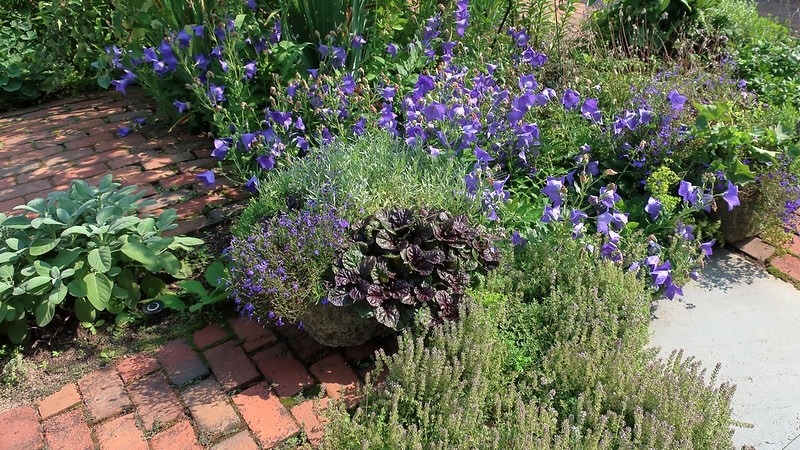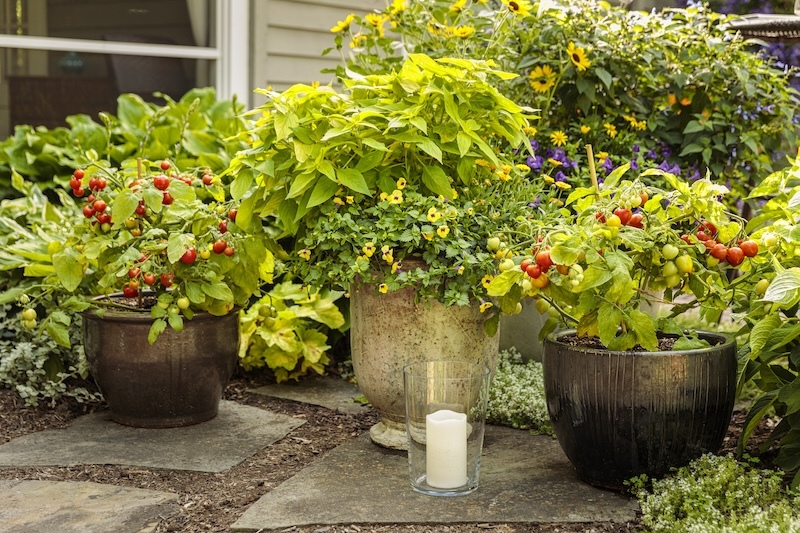No formal herb garden should be without culinary sage. The coarse texture and savory flavor of the leaves are essential in many poultry and pork dishes. The flavor of roasted winter squash gets a significant boost when butter and sage are added to the roasting tray. And who can forget the popularity of deep-fried sage leaves as a garnish for fusion recipes in the 1990s?
Salvia officinalis is a woody perennial herb, often grown for medicinal and culinary uses, although its pleasing shape and semi-evergreen habit make it a useful ornamental plant for a garden border or container garden.

Photo by K M, unmodified, Flickr, copyright CC BY 2.0
Culinary sage requires well-draining soil year-round and at least 6-8 hours of direct sun exposure from spring to first frost. Annual fertilizing is typically not needed when sage is planted in average garden soil. This woody perennial also rarely requires supplemental watering during the summer, although container-grown plants should be watered regularly to keep the soil moist during periods of drought and high heat.
Shrubs To Plant With Culinary Sage
Culinary sage combines effortlessly with other Mediterranean shrubs and woody herbs in a garden border. Plant sage with thyme, lavender, rosemary, and bay laurel, which are all edible, ornamental plants and thrive in poor, dry soils like sage. Other interesting xeric plants such as bottlebrush shrub, California lilac, and artemisia grow well with sage and add height and structure to an herb border for 12 months of the year. These shrub choices also attract pollinators and make a low-maintenance planting.
Perennials To Plant With Culinary Sage
Summer-blooming perennials that appreciate drier soil conditions make nice companions for culinary sage. Choose drought-tolerant plants like agapanthus, globe thistle, and jerusalem sage for a long-lasting and impressive flower display late in summer. Lower-growing perennials like ajuga, sedum, and sempervivum can be planted densely to form a living mulch that helps to cool the soil while suppressing weeds around sage. For added color, include bulbs that thrive in dry summer conditions such as ornamental alliums for late spring blooming or saffron crocus for early fall color.

Photo by K M, unmodified, Flickr, copyright CC BY 2.0
Annuals To Plant With Culinary Sage
Sage planted in the vegetable garden has a few beneficial functions. Culinary use is the obvious function, but sage can also deter a wide range of pests from annual crops. Cabbage, carrots, cauliflower, and broccoli are all susceptible to cabbage moths and their larvae. The scent of sage in the garden confuses the pests, making them less likely to infest vegetable crops.
You can also combine sage with other annual herbs to create dedicated theme beds, such as Italian herbs, herbes des Provence, or winter vegetable seasoning mixes. You might start with basil, tarragon, marjoram, and chervil, and add other favorites.

Best Companion Plants For Culinary Sage in Containers
Sage may have a reputation for being green and boring, but varieties like pineapple, tricolor, and purple sage bring the wow. These colorful selections grow well in a container with other sun lovers like ornamental peppers, snapdragons, thyme, oregano, and lemon balm. For an edible arrangement, add a patio-type tomato or prostrate rosemary to spill over the edge and soften any hard lines. Tie the combination together with select colors of torenia or creeping zinnia which will bloom until first frost.

Photo by K M, cropped, Flickr, copyright CC BY 2.0
Plants Not To Grow With Culinary Sage
Culinary sage should not be planted near the bitter herbs rue and fennel. These can impart a bitter flavor to sage and sometimes inhibit overall growth. Onions and cucumbers will also inhibit sage growth and should be planted farther away. Plants that thrive in boggy soil or pondside conditions are especially unsuitable companions. Sage requires well-drained soil and will rot in boggy conditions.
Best Plants To Grow With Culinary Sage
Sage requires full sun exposure and excellent drainage. It combines well with other Mediterranean woody herbs (lavender, thyme, rosemary) and sun-loving annuals. For bold color, pair culinary sage with petunias, calibrachoa, and creeping zinnias, which all have long blooming periods and will happily grow in the garden or a container.
